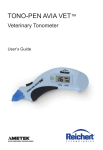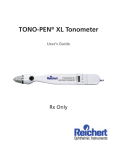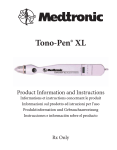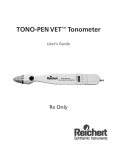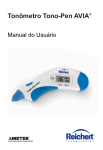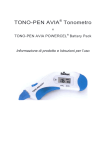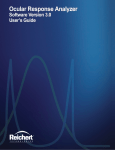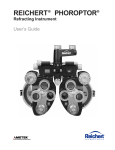Download Reichert TONO-PEN VET User`s guide
Transcript
Tono-Pen VET™ Veterinary Tonometer User’s Guide ©2014 AMETEK, Inc. Reichert, Reichert Technologies, Tono-Pen and Ocu-Film are registered trademarks of Reichert, Inc. OCU-CEL and Tono-Pen VET are trademarks of Reichert, Inc. AMETEK is a registered trademark of AMETEK, Inc. All other trademarks are property of their respective owners. The information contained in this document was accurate at time of publication. Specifications subject to change without notice. Reichert, Inc. reserves the right to make changes in the product described in this manual without notice and without incorporating those changes in any products already sold. ISO 9001/13485 Certified – Reichert products are designed and manufactured under quality processes meeting ISO 9001/13485 requirements. No part of this publication may be reproduced, stored in a retrieval system, or transmitted in any form or by any means, electronic, mechanical, recording, or otherwise, without the prior written permission of Reichert, Inc. Caution: Federal law restricts this device to sale by or on the order of a licensed physician. Rx only. Table of Contents Warnings & Cautions��������������������������������������������������������4 Symbols����������������������������������������������������������������������������8 Introduction�����������������������������������������������������������������������9 Indications for Use�������������������������������������������������������9 Contraindications���������������������������������������������������������9 Device Description����������������������������������������������������10 Features��������������������������������������������������������������������10 Parts Identification����������������������������������������������������� 11 Available Accessories������������������������������������������������ 11 Setup������������������������������������������������������������������������������12 Battery Installation�����������������������������������������������������12 Tono-Pen VET Tonometer Preparation����������������������13 Calibration Procedure������������������������������������������������14 Instructions for Use��������������������������������������������������������16 Performing IOP Measurements���������������������������������16 Interpreting the LCD Screen��������������������������������������19 Cleaning & Maintenance������������������������������������������������20 Cleaning Instructions�������������������������������������������������20 Tono-Pen VET Body��������������������������������������������������21 Battery Replacement�������������������������������������������������21 Storage����������������������������������������������������������������������22 Disposal���������������������������������������������������������������������22 Troubleshooting��������������������������������������������������������������23 Specifications�����������������������������������������������������������������24 Guidance and Manufacturer’s Declaration���������������������25 Warranty�������������������������������������������������������������������������28 Customer Service Information����������������������������������������29 68E3527 Rev. F Page 3 Warnings & Cautions WARNING: AN INSTRUCTION THAT DRAWS ATTENTION TO RISK OF INJURY OR DEATH. WARNING: UNITED STATES FEDERAL LAW AND EUROPEAN REGULATIONS REQUIRE THAT THIS DEVICE BE PURCHASED ONLY BY A PHYSICIAN OR A PERSON ACTING ON BEHALF OF A PHYSICIAN. WARNING: DO NOT REPAIR OR SERVICE THIS INSTRUMENT WITHOUT AUTHORIZATION FROM THE MANUFACTURER. ANY REPAIR OR SERVICE TO THIS INSTRUMENT MUST BE PERFORMED BY EXPERIENCED PERSONNEL OR DEALERS WHO ARE TRAINED BY REICHERT OR SERIOUS INJURY TO THE OPERATOR OR PATIENT MAY OCCUR. WARNING: THIS INSTRUMENT SHOULD BE USED IN STRICT ACCORDANCE WITH THE INSTRUCTIONS OUTLINED IN THIS USER’S GUIDE. THE SAFETY OF THE OPERATOR AND THE PERFORMANCE OF THE INSTRUMENT CANNOT BE GUARANTEED IF USED IN A MANNER NOT SPECIFIED BY REICHERT TECHNOLOGIES. WARNING: MODIFICATIONS TO THIS INSTRUMENT ARE NOT ALLOWED. ANY MODIFICATION TO THIS UNIT MUST BE AUTHORIZED BY REICHERT OR SERIOUS INJURY TO THE OPERATOR OR PATIENT MAY OCCUR. WARNING: IF THIS INSTRUMENT IS MODIFIED, APPROPRIATE INSPECTION AND TESTING MUST BE CONDUCTED TO ENSURE CONTINUED SAFE USE OF THIS INSTRUMENT. WARNING: DO NOT USE THE TONO-PEN VET TONOMETER ON A PATIENT WITHOUT AN OCU-FILM + TIP COVER OR INACCURATE READINGS MAY BE OBTAINED. WARNING: DO NOT USE AN OCU-FILM + TIP COVER FOR MORE THAN ONE PATIENT TO HELP PREVENT CROSS CONTAMINATION. WARNING: IT IS IMPERATIVE THAT A FRESH OCU-FILM + TIP COVER BE USED FOR EACH PATIENT FOR THE PROTECTION OF THE EYE AND THE TRANSDUCER ASSEMBLY. THE TRANSFER OF INFECTION IS THUS PREVENTED. REPLACE OCU-FILM + TIP COVERS AFTER EXAMINATION OF EACH PATIENT. WARNING: DO NOT USE THE TONO-PEN VET TONOMETER IF THE TRANSDUCER ASSEMBLY IS CRACKED, CHIPPED OR SHOWS ANY IRREGULARITY OF THE SURFACE, TO PREVENT PATIENT INJURY, AND/ OR INACCURATE READINGS. WARNING: DO NOT USE EXCESSIVE PRESSURE DURING APPLANATION OR EYE INJURY MAY OCCUR. Page 4 68E3527 Rev. F Warnings & Cautions (continued) WARNING: THE CORNEAL SURFACE NEEDS ONLY TO BE MOMENTARILY CONTACTED, INDENTATION OR ADDITIONAL PRESSURE AFTER THE AUDIO “CHIRP” TONE IS HEARD IS NOT REQUIRED AND MAY LEAD TO DAMAGE TO THE EYE. WARNING: OCU-FILM + TIP COVERS CONTAIN NATURAL LATEX WHICH MAY CAUSE ALLERGIC REACTIONS. QUESTION PATIENTS ABOUT ALLERGIES TO LATEX BEFORE MEASURING THEM WITH THE TONOPEN VET TONOMETER. WARNING: DO NOT CARRY THE TONO-PEN VET OCU-CEL BATTERIES IN A POCKET, OR CLOSE TO YOUR PERSON, AS A BURN INJURY MAY RESULT. WARNING: THE BATTERY SHOULD ONLY BE REPLACED WITH THE BATTERY SPECIFIED IN THIS MANUAL. USE OF ANOTHER BATTERY MAY CAUSE FIRE OR AN EXPLOSION. WARNING: DO NOT PLACE A SHORTING DEVICE BETWEEN THE BATTERY TERMINALS, OR ALLOW THE BATTERY TO BECOME WET. MISUSE OR IMPROPER DISPOSAL OF THIS BATTERY MAY CAUSE IT TO BECOME VERY HOT, IGNITE OR EXPLODE. DAMAGE TO THIS UNIT AND/OR SERIOUS PERSONAL INJURY MAY RESULT. WARNING: DO NOT RECHARGE THE BATTERY. THE BATTERY IS NOT DESIGNED TO BE CHARGED BY ANY ELECTRICAL SOURCE. CHARGING COULD GENERATE GAS AND INTERNAL SHORTCIRCUITING, LEADING TO DISTORTION, LEAKAGE, OVERHEATING, EXPLOSION OR FIRE. WARNING: DO NOT EXPOSE THE BATTERY TO TEMPERATURES ABOVE 140ºF, DISASSEMBLE THE BATTERIES, OR DAMAGE TO THIS UNIT AND/ OR SERIOUS PERSONAL INJURY MAY RESULT. WARNING: NEVER ALLOW LIQUID LEAKING FROM THE BATTERY TO GET IN YOUR EYES OR MOUTH AS THIS LIQUID COULD CAUSE SERIOUS PERSONAL INJURY. IF IT COMES IN CONTACT WITH YOUR EYES OR MOUTH, FLUSH THEM IMMEDIATELY WITH PLENTY OF WATER AND CONSULT A PHYSICIAN. WARNING: ALWAYS KEEP BATTERIES OUT OF THE REACH OF INFANTS AND YOUNG CHILDREN TO PREVENT THEM FROM BEING SWALLOWED. IF SWALLOWED, CONSULT A PHYSICIAN IMMEDIATELY. WARNING: THE USE OF ACCESSORIES OR CABLES OTHER THAN THOSE SPECIFIED, WITH THE EXCEPTION OF THOSE SOLD BY THE MANUFACTURER AS REPLACEMENT PARTS FOR INTERNAL COMPONENTS, MAY RESULT IN INCREASED EMISSIONS OR DECREASED IMMUNITY OF THE EQUIPMENT OR SYSTEM. 68E3527 Rev. F Page 5 Warnings & Cautions (continued) CAUTION: AN INSTRUCTION THAT DRAWS ATTENTION TO THE RISK OF DAMAGE TO THE PRODUCT. CAUTION: DO NOT USE THE TONO-PEN VET TONOMETER WITHOUT AN OCU-FILM + TIP COVER TO PREVENT DAMAGE TO THE TRANSDUCER ASSEMBLY. CAUTION: DO NOT TOUCH THE TRANSDUCER ASSEMBLY WITHOUT AN OCU-FILM + TIP COVER APPLIED OR DAMAGE TO THE TRANSDUCER ASSEMBLY MAY RESULT. CAUTION: DO NOT BUMP, JAR OR DROP THE DEVICE, OR DAMAGE TO THE ELECTRONICS MAY OCCUR. CAUTION: DO NOT IMMERSE THE TONO-PEN VET TONOMETER IN FLUIDS OR DAMAGE TO THE ELECTRONICS MAY OCCUR. CAUTION: DO NOT USE SOLVENTS OR STRONG CLEANING SOLUTIONS ON ANY PART OF THIS INSTRUMENT AS DAMAGE TO THE UNIT MAY OCCUR. SEE MAINTENANCE SECTION FOR DETAILED CLEANING INSTRUCTION. CAUTION: USE OF AMMONIA BASED CLEANERS ON THE LIQUID CRYSTAL DISPLAY (LCD) MAY CAUSE DAMAGE TO THE DISPLAY. SEE MAINTENANCE SECTION FOR DETAILED CLEANING INSTRUCTION. CAUTION: DO NOT ATTEMPT TO STERILIZE THE TONO-PEN VET TONOMETER OR DAMAGE TO THE ELECTRONICS MAY OCCUR. CAUTION: DO NOT AUTOCLAVE OR DISINFECT USING HIGH TEMPERATURES EXCEEDING THE RECOMMENDED TEMPERATURES INDICATED IN THE SPECIFICATIONS SECTION OF THIS MANUAL OR DAMAGE TO THE UNIT MAY OCCUR. CAUTION: DO NOT ATTEMPT TO MODIFY THE TONO-PEN VET TONOMETER OR THE TONO-PEN VET OCU-CEL BATTERIES OR DAMAGE TO THE DEVICE MAY OCCUR. CAUTION: DO NOT STORE THE TONO-PEN VET TONOMETER WITHOUT AN OCU-FILM + TIP COVER OR DEBRIS MAY ENTER THE TRANSDUCER ASSEMBLY AND CAUSE MALFUNCTIONS. CAUTION: MEDICAL ELECTRICAL EQUIPMENT NEEDS SPECIAL PRECAUTIONS REGARDING EMC AND NEEDS TO BE INSTALLED AND PUT INTO SERVICE ACCORDING TO THE EMC INFORMATION PROVIDED IN THIS GUIDE. PORTABLE AND MOBILE RF COMMUNICATIONS EQUIPMENT CAN AFFECT MEDICAL ELECTRICAL EQUIPMENT. Page 6 68E3527 Rev. F Warnings & Cautions (continued) CAUTION: ELECTROMAGNETIC INTERFERENCE FROM OTHER DEVICES MAY AFFECT THIS INSTRUMENT. IF INTERFERENCE IS PRESENT, TURN OFF OTHER ELECTRONIC DEVICES, OR REMOVE THEM FROM THE IMMEDIATE AREA WHILE OPERATING THIS INSTRUMENT. CAUTION: PORTABLE AND MOBILE RF COMMUNICATIONS EQUIPMENT CAN EFFECT MEDICAL ELECTRICAL EQUIPMENT. CAUTION: THIS INSTRUMENT IS NOT TO BE USED NEAR HIGHFREQUENCY EMITTING SURGICAL EQUIPMENT. CAUTION: OCU-FILM + TIP COVERS SHOULD BE STORED BETWEEN 35° AND 80° FAHRENHEIT (2°-27° CELSIUS). CAUTION: EACH BOX OF HIGH QUALITY OCU-FILM + TIP COVERS HAS A “USE BEFORE” DATE STAMPED ON THE BOX. WE SUGGEST USE OF OUR OCU-FILM + BEFORE THIS DATE TO GUARD AGAINST THE POSSIBILITY OF SHELF WEAR. THE LATEX MATERIAL USED IN THE OCU-FILM + TIP COVERS CAN DEGRADE. A DEGRADED FILM MAY RESULT IN LEAKAGE OF WETTING SOLUTION AND INSTRUMENT DAMAGE. EXAMINE EACH OCU-FILM + TIP COVER FOR YELLOWING, CRACKS, OR A STICKY TEXTURE PRIOR TO USE. 68E3527 Rev. F Page 7 Symbols Caution, See Instructions for use REF SN 2014 Catalog Number Serial Number Date of Manufacture Waste of Electrical and Electronic Equipment Compliance to Medical Device Directive 93/42/EEC Consult Instructions for Use Authorized Representative in European Community Fragile Contents in Shipping Container - handle with care Do not get Shipping Container wet Type BF Applied Part SYMBOLS FOR OCU-FILM + TIP COVERS ONLY Do not reuse. Single Use Use By LOT Lot Number Contains natural rubber latex Page 8 68E3527 Rev. F Introduction Congratulations on your purchase of the Tono-Pen VET™ tonometer. The Tono-Pen VET tonometer is a prescription only device intended for measuring intraocular pressure (IOP) during routine eye examinations or when increased intraocular pressure is suspected by properly trained eyecare professionals such as veterinarians, and veterinary technicians. Note: The Tono-Pen VET is not approved for use on humans. This User’s Guide is designed as a training and reference manual for operation, maintenance, and troubleshooting. We recommend that you read it carefully prior to use and follow the instructions in the guide to ensure optimum performance of your new instrument. If used properly, the Tono-Pen VET tonometer will provide you with fast, accurate and reliable measurements for many years. Properly trained eyecare professionals such as veterinarians, and veterinary technicians should operate this instrument. Please retain this manual for future reference and to share with other users. For additional copies of this manual or questions related to the Tono-Pen VET tonometer, contact your local authorized Reichert® dealer or contact our Customer Service department directly at: Tel: 716-686-4500 Fax: 716-686-4555 E-mail: [email protected] Indications for Use The indications for use include measuring intraocular pressure (IOP) for suspected glaucoma, or when increased intraocular pressure is suspected. Contraindications None. 68E3527 Rev. F Page 9 Introduction (continued) Device Description The Reichert Tono-Pen VET is a precision electronic tonometer which measures intraocular pressure (IOP). The body of the instrument is specially designed to fit comfortably in the user’s hand, facilitating fast and accurate measurements. The stainless steel probe on the TonoPen VET contains a solid state strain gauge which converts intraocular pressure (IOP) to an electrical signal. The probe tip must be covered by a protective membrane. Reichert Ocu-Film ® Tip Covers are recommended. Utilizing a sophisticated “single chip” microprocessor and electronics housed in the body of the instrument, the waveform produced by each touch to the anesthetized corneal surface is analyzed and stored for a statistical comparison process. Each single valid IOP reading is digitally displayed on the liquid crystal display (LCD). When four valid readings are obtained, the mean IOP and the standard deviation for those readings (an indication of reliability) are shown on the LCD. Features The Tono-Pen VET tonometer has the following features: • Easy to use - IOP can be measured reliably by veterinary professionals. • Portable - The Tono-Pen VET tonometer weighs just 59.4 g (2.1 oz) and is battery operated. • Accurate - The measurements from the Tono-Pen VET tonometer correlate strongly with Goldmann applanation tonometry and direct measurements of IOP. • Versatile - The Tono-Pen VET tonometer may be used easily with the patient in any position, making the instrument suitable for the office, in glaucoma clinics, at the hospital bedside, and in remote locations. Page 10 68E3527 Rev. F Introduction (continued) Parts Identification A. B. C. D. Tip – location of sensor. Transducer Assembly - housing for sensor. Activation Button - Applanation Mode select button. LCD - displays the IOP in mmHg, statistical confidence indicator, and battery life status. E. Battery Compartment- Where the batteries are located. A E C D B Figure 1 Parts Identification Available Accessories 230570 230651 230652 230653 23065070 23050140 68E527 68E3527 Rev. F Tono-Pen OCU-CEL™ Battery Ocu-Film® (150 per box) Ocu-Film (200 count bulk bag) Ocu-Film (600 count bulk bag) Carrying Case Stylus (opening case and battery removal) User’s Guide Page 11 Setup Battery Installation The Tono-Pen VET tonometer is shipped without the batteries installed. The batteries need to be installed prior to using the instrument. The Tono-Pen VET is supplied with four OCU-CEL 3.0 volt lithium manganese dioxide batteries. Note: The Tono-Pen VET unit will not function properly with mercury batteries. Note: It is recommended that Reichert OCU-CEL Batteries be used when the batteries need replacement. 1. Open the battery compartment by gently inserting the stylus blade in the end slot. After insertion, slowly push the stylus forward and pry the cover up to remove. Refer to Figure 2. CAUTION: CHECK TO BE SURE THAT THE BATTERIES ARE INSTALLED CORRECTLY. INCORRECT INSTALLATION COULD CAUSE SEVERE DAMAGE TO THE ELECTRONICS AND VOID THE WARRANTY. 2. Install two batteries. Refer to Figure 3. Note: Check to be sure that the plus side of the battery is installed facing the plus side, and the minus is installed facing the minus side. The batteries positive and negative ends are marked on the battery. The flat side is the positive end. 3. Replace the battery cover. - + + - Flat End of Stylus Figure 2 Open Battery Compartment Page 12 Figure 3 Battery Installation 68E3527 Rev. F Setup (continued) Tono-Pen VET Tonometer Preparation 1. 2. 3. 4. Allow the instrument to thermally stabilize to room temperature for approximately 30 minutes prior to use. Remove the storage Ocu-Film + tip cover from the Transducer Assembly. Visually inspect the Transducer Assembly for cracks, chips or other irregularities. Do not use if these conditions are present. Slide an Ocu-Film + Tip Cover onto the Transducer Assembly until the ridge is seated, taking care not to apply the tip cover too tightly or too loosely. Make certain that the rubber is flat across the tip, but not taut. Refer to Figure 4. OCU-FILM Tip Cover CORRECT OCU-FILM Tip Cover Too Loose OCU-FILM Tip Cover Too Tight Figure 4 Ocu-Film Tip Cover Placement 5. Perform the Calibration procedure. Note: Calibration should only be performed on the Tono-Pen once daily, unless otherwise indicated by the instrument. The Tono-Pen does not require calibration after every patient examination. Note: Use of the Ocu-Film + Tip Cover is required under original Tono-Pen instrument warranty and service contract terms. Note: Corneal topical anesthetic is required with tonometry. 68E3527 Rev. F Page 13 Setup (continued) Calibration Procedure The Tono-Pen VET unit is internally calibrated, thus the instrument calibration should be checked only before the first use each day or in the event of unanticipated readings. Calibration must be routinely and successfully performed once daily prior to instrument use. Calibration should also be performed whenever it is indicated by the LCD display, when batteries are replaced, or after an unsuccessful calibration. It is not necessary to check calibration prior to each use. 1. Point the transducer end of the Tono-Pen straight down towards the floor. Refer to Figure 5. 2. Depress the Operator’s Button two times rapidly. The time between the first and second button press must be between 0.5 and 1.5 seconds. The Tono-Pen will “beep” and display [CAL]. 3. Wait approximately 15 seconds for the Tono-Pen to “beep”. The display will change from [CAL] to [UP]. 4. Immediately (within 1 second) invert the Tono-Pen smoothly, pointing the transducer end straight up. Refer to Figure 5. 5. A properly functioning Tono-Pen will display [Good] followed by a “beep”. 6. Repeat this Calibration Procedure if [bAd] is displayed. 7. After Good is displayed, depress the Operator’s Button one time and the Tono-Pen will display [8.8.8.8], followed by a single row of dashes, [- - - -], and then by a double row of dashes [====] followed by a “beep” tone, indicating the instrument is ready to measure IOP (Depressing the activation button a second time will interrupt this process and send the unit to calibration mode). Figure 5 Calibration Procedure - Up - Down Page 14 68E3527 Rev. F Setup (continued) Calibration Procedure (continued) If several consecutive attempts at checking the calibration are unsuccessful: •Loosen or remove the Ocu-Film Tip Cover from the Tono-Pen VET probe tip and repeat the calibration check. •Spray the probe tip with compressed gas, and repeat the calibration check. •Replace the batteries and repeat the calibration check. Note: If [CAL] appears followed by a row of four dashes [- - - -], the unit did not go into calibration mode. To correct this, depress the button quicker two times or slower two times. Note: Do not take measurements with the instrument if two consecutive [good] calibration checks cannot be obtained. The instrument will not take a measurement when the prior calibration check was [bAd]. Note: If the Tono-Pen VET fails to yield a [Good] calibration, call Reichert Technical Service. 68E3527 Rev. F Page 15 Instructions for Use Performing IOP Measurements CAUTION: OCU-FILM CONTAINS NATURAL RUBBER LATEX WHICH MAY CAUSE ALLERGIC REACTIONS. QUESTION PATIENTS ABOUT ALLERGIES TO LATEX BEFORE EXAMINING THEM WITH THE TONO-PEN VET. 1.Instill a drop of topical anesthetic onto the eye to be examined. 2.Position and secure the patient to minimize eye movement. Note: The Tono-Pen VET unit will function in any stable position. 3. Hold the Tono-Pen VET unit as you would a pencil and position yourself to facilitate viewing of the probe tip and patient’s cornea where contact will be made. For normal corneas, central corneal contact is recommended. 4. The corneal surface needs only to be momentarily contacted. Indentation or additional pressure is not required and may lead to injury to the eye. Refer to Figure 6. CORRECT INCORRECT Figure 6 Corneal Applanation 5. Hold the Tono-Pen VET so that it is perpendicular to and within 1/2 inch of the patient’s cornea. Refer to Figure 6 for correct positioning. 6. To initiate an IOP measurement, depress the Operator’s Button once, and only once. 7. Initially you will see a brief display of [8.8.8.8]. This is a self-test of the LCD (Liquid Crystal Display). Note: If any of the LCD segments are not displayed, the Tono-Pen requires service. Note: If a momentary display of [CAL] is seen, followed immediately by a single row of dashes [- - - -], it indicates that the Tono-Pen requires calibration before it will measure. Page 16 68E3527 Rev. F Instructions for Use (continued) Performing IOP Measurements (continued) 8.If a double row of dashes [====] is seen and a “beep” tone is heard, it indicates that the Tono-Pen is ready to measure IOP. Proceed with applanation within 15 seconds. Note: After acquiring the double row of dashes [====], if more than 15 seconds elapses prior to applanation, the Tono-Pen will not measure. The software will have initiated a battery-saving function, indicated initially by the display of a single row of dashes [- - - -], then followed in sequence by a blank display [ ]. A new IOP measurement can be initiated by depressing the operator’s button once. Note: Anytime the operator’s button is depressed twice within 1.5 seconds, (which may be caused by operator’s inadvertent pressure on the button) the software will interpret this as a demand for calibration. Then a sustained display of [CAL] will be seen which initiates the calibration sequence. The calibration sequence must be successfully completed before further measurements can be accomplished. 9. Once activated, after [====] is displayed and a “beep” tone is heard, touch the Tono-Pen VET unit to the cornea lightly and briefly, then withdraw. Repeat several times. The corneal surface needs only to be momentarily contacted; indentation is not required and may lead to inaccurate readings. 10.A chirp will sound and a digital IOP measurement will be displayed each time a valid reading is obtained. The single horizontal bar at the bottom of the LCD, indicating statistical reliability, will not be displayed with each single IOP measurement. 11. After four (4) valid readings are obtained, a final beep will sound and the averaged measurement will appear on the LCD along with the single bar denoting statistical reliability. Note:If a single row of dashes [- - - -] appears on the LCD after the final beep, an insufficient number of valid readings was collected. If this occurs, repeat the patient examination procedure, starting at step 1. -continued- 68E3527 Rev. F Page 17 Instructions for Use (continued) Performing IOP Measurements (continued) To take another measurement, reactivate the Tono-Pen VET unit by pressing and releasing the activation switch as described in step 5. Note: If not reactivated within 25 seconds, the Tono-Pen VET unit will automatically turn off and the LCD will clear, placing the device in sleep mode, to conserve battery life. If this occurs, activate the TONO-PEN VET by pressing the Operator’s Button once. 12.Replace the Ocu-Film Tip Cover before using the Tono-Pen VET unit on another patient and before storage. Note: Failure to replace the Ocu-Film Tip Cover between patients may result in unreliable readings of IOP by allowing debris to enter the transducer assembly. Note: A reused Ocu-Film Tip Cover may leak. This may cause damage to the strain gauge and void the Warranty. Page 18 68E3527 Rev. F Instructions for Use (continued) Interpreting the LCD Screen The number display represents IOP in millimeters of mercury (mmHg.) A number with a single horizontal bar displayed at the bottom of the LCD is an average of the valid measurements. A number without the single bar is a single measurement of IOP. Refer to Figure 7. The display of one of four horizontal bars located along the lower border of the LCD block indicates the statistical reliability of the averaged measurement. For example, if the 5% bar is displayed, the standard deviation of the valid measurements is 5% or less of the number shown. If the reliability measure is 20% or > 20%, a repeat measurement is recommended. A single row of dashes [- - - -] indicates that the instrument is activated. Two rows of dashes [====] followed by a “beep” indicates that the instrument is ready to take measurements. • “CAL” indicates that the instrument is in • • • • the process of calibration check or the instrument needs to undergo calibration check procedure. If “CAL” is displayed following a long beep and “- - - -”, the latter is the case. A “Good” calibration check must be obtained. “Lob” indicates the need to replace both batteries prior to using the instrument. “UP” indicates that the instrument is being calibrated and the probe tip should be turned from pointing down to pointing up. “Good” indicates the calibration check procedure was successful. After two “Good” calibration checks, the Tono-Pen VET unit is ready for use in patient examinations. “bAd” indicates the calibration check procedure was unsuccessful and must be repeated. 68E3527 Rev. F Figure 7 LCD Showing A Single IOP Measurement Of 20 Page 19 Cleaning & Maintenance Cleaning Instructions The Tono-Pen VET tonometer may have difficulty taking measurements or display “Fail” after a verification when its tip is dirty and requires cleaning. When the Transducer Assembly of the tonometer has dirt and contaminants in the tip, cleaning of the tip is necessary. When the tip contains contaminants, cannot move freely and the Tono-Pen VET may have erratic readings and then show a “Fail” verification. Figure 8 Cleaning the Tip it 1. Remove Ocu-Film + tip cover from the tonometer, if one is installed. 2. Using canned air, place the tip of the Transducer Assembly against the outlet of the canned air as shown in Figure 8. 3. Blow the canned air into the tip of the tonometer for approximately 3 seconds. Note: It is necessary to blow canned air directly into the tip so that the contaminants are pushed out. 4. After cleaning the tip with compressed air, the Transducer Assembly will be cold. Allow the Transducer Assembly to warm to room temperature. 5. Perform the tonometer verification as indicated in the Tono-Pen VET Tonometer Verification section of this manual. Note: If the tonometer does not “Pass” the verification procedure, then repeat the above cleaning instructions. Do not clean more than 3 times in a row. If the tonometer still will not pass verification, contact Reichert. Note: Never use the Tono-Pen VET tonometer without an Ocu-Film + tip cover installed. Note: O cu-Film + tip covers are the only manufacturer approved covers for use with the Tono-Pen VET tonometer. Use of any other type of branded tip cover may affect readings or may void your warranty. Note: Always store the Tono-Pen VET tonometer with an Ocu-Film + tip cover installed to protect the tonometer tip from dirt and contaminants. contaminants. Page 20 68E3527 Rev. F Cleaning & Maintenance (continued) Suggested Cleaning Schedule Number of Patients per Week 10 100 300 600 Number of Days Between Cleaning 30 15 7 1 Tono-Pen VET Body Avoid any shock or excessive vibration which will damage the unit. Clean with a non-abrasive, dry cloth. CAUTION: DO NOT IMMERSE TONO-PEN VET BODY IN FLUIDS. THIS WILL CAUSE DAMAGE TO THE ELECTRONICS AND VOID THE WARRANTY. Battery Replacement The batteries need replacing when multiple beeps sound and “Lob” appears on the LCD upon depressing the activation switch. Occasionally, a noticeable slowing in the calibration check process or in activating the instrument for taking measurements may suggest that the batteries need replacing. Note: Replace the battery with P/N 230570. Note: Always replace both batteries. Do not mix used and new batteries in the instrument. Reichert OCU-CEL batteries are recommended. Note: The instrument will not function properly when mercury batteries are Figure 9 Remove Batteries used. Replace the batteries using the procedure described in the Battery Installation section. Remove the battery cover and then remove the batteries using the Stylus. Refer to Figure 9. Note: One end of the Stylus has a thin pointed end. Insert this end into the holes on the back of the pen to remove the batteries. If the instrument is not to be operated for an extended period of time, remove both batteries. This will avoid possible damage to the instrument due to battery leakage. 68E3527 Rev. F Page 21 Cleaning & Maintenance (continued) Storage • Cover the tip with an Ocu-Film + tip cover for protection. • If the Tono-Pen VET tonometer is not to be used until a subsequent day, the instrument and accessories should be placed in the storage case provided. • If the instrument is to be stored for an extended period, remove the Tono-Pen VET OCU-CEL Batteries to avoid possible damage to the instrument due to battery leakage. Disposal The Tono-Pen VET, Ocu-Film, and Tono-Pen VET OCU-CEL do not generate any environmentally hazardous residues. At the end of its product service life, follow your local laws and ordinances regarding the proper disposal of this equipment. Page 22 68E3527 Rev. F Troubleshooting The table below provides a guide for troubleshooting some basic Tono-Pen VET tonometer operational problems. If a problem persists after using this guide contact Reichert technical services. SYMPTOM “Lob” displayed on LCD Screen Noticeable slowing in the calibration check process, in activating instrument Multiple inaccurate readings No beeps and/or no dashes upon activation Unable to obtain “Good’ calibration check Unit displays “CAL” then single dashed line then turns off. 68E3527 Rev. F PROBABLE CAUSE CORRECTION Low Tono-Pen VET OCU-CEL Battery capacity Replace Tono-Pen VET OCU-CEL Batteries Low Tono-Pen VET OCU-CEL Battery capacity Replace Tono-Pen VET OCU-CEL Batteries Compressed air cleaning has lowered the temperature of the instrument Allow Tono-Pen VET unit to warm to room temperature Improper technique Review “INSTRUCTIONS FOR USE” Section of this manual Old or improperly applied Ocu-Film + tip cover Replace Ocu-Film tip cover Low Tono-Pen VET OCU-CEL Battery capacity Replace Tono-Pen VET OCU-CEL Batteries Need to check calibration Perform calibration check procedure. Debris in tip Clean tip Mechanical or electronic damage Arrange for service through Reichert Technical Service Group Activation button not properly pressed Press Activation button Activation switch not depressed long enough Depress activation switch longer Low Tono-Pen VET OCU-CEL Battery capacity Replace Tono-Pen VET OCU-CEL Batteries Mechanical or electronic damage Arrange for service through Reichert Technical Service Group Debris in tip Clean tip Compressed air cleaning has lowered the temperature of the instrument Allow Tono-Pen VET tonometer unit to warm to room temperature Button pressed too quickly or too slowly Press the button twice, a little slower or faster until the word CAL appears on the screen and stays on the screen. If the single row of dashed lines appears, repeat the double press. Page 23 Specifications Catalog Number: 230635V PHYSICAL DIMENSIONS Size: 7 1/4” x 1” x 7/8” (18.42 x 2.54 x 2.22 cm) Weight:2.1 oz. (59.4 g) 60°C -10°C 95% 50% 106 kPa 50 kPa RANGE OF IOP MEASUREMENTS 5-80 mmHg ENVIRONMENTAL REQUIREMENTS Operational Environment Ambient Temperature range: 15° to 35°C (59° to 95°F) Relative Humidity range: 30 to 75% Atmospheric Pressure range: 80 kPa to 106 kPa (23.6 to 31.3 in.Hg) Transport and Storage Environment Ambient Temperature range: -10° to 60°C (14° to 140°F) Relative Humidity range: 50 to 95% (non-condensing) Atmospheric Pressure range: 50 kPa to 106 kPa (14.8 to 31.3 in.Hg) ELECTRICAL Input Voltage (Tono-Pen OCU-CEL Batteries) 2 x 3V Lithium Manganese Dioxide batteries OCU-FILM + TIP COVER Contains natural rubber latex SOFTWARE REVISION The software revision can be obtained by contacting Reichert Technologies. The serial number identifies the manufacture date and will provide access to the software version Page 24 68E3527 Rev. F Guidance & Manufacturer’s Declaration Table 201 – Guidance and Manufacturer’s Declaration Electromagnetic Emissions All Equipment and Systems Guidance and Manufacturer’s Declaration – Electromagnetic Emissions The Tono-Pen VET is intended for use in the electromagnetic environment specified below. The customer or user of the Tono-Pen VET should ensure that it is used in such an environment. Emissions Test Electromagnetic Environment Compliance RF Emissions CISPR 11 Group 1 Class B Harmonics IEC 61000-3-2 N/A Flicker IEC 61000-3-3 N/A - Guidance - The Tono-Pen VET uses RF energy only for its internal function. Therefore, its RF emissions are very low and are not likely to cause any interference in nearby electronic equipment. The Tono-Pen VET is suitable for use in all establishments, including domestic establishments and those directly connected to the public low-voltage power supply network that supplies building for domestic power. Table 202 – Guidance and Manufacturer’s Declaration Electromagnetic Immunity All Equipment and Systems Guidance and Manufacturer’s Declaration – Electromagnetic Immunity The Tono-Pen VET is suitable for use in electromagnetic environment specified below. The customer or user of the Tono-Pen VET should ensure that it is used in such an environment. Immunity Test IEC 60601 Test Level Compliance Level Electromagnetic Environment - Guidance ESD IEC 61000-4-2 ±6kV Contact ±8kV Air ±6kV Contact ±8kV Air Floors should be wood, concrete or ceramic tile. If floors are synthetic, the R/H should be at least 30%. EFT IEC 61000-4-4 ±2kV Mains ±1kV I/Os N/A Mains power quality should be that of a typical residential, commercial or hospital environment. Surge IEC 61000-4-5 ±1kV Differential ±2kV Common N/A Mains power quality should be that of a typical residential, commercial or hospital environment. N/A Mains power quality should be that of a typical residential, commercial or hospital environment. If the user of the Tono-Pen VET requires continued operation during power mains interruptions, it is recommended that the Tono-Pen VET be powered from an uninterruptible power supply or battery. 3 A/m Power frequency magnetic fields should be that of a typical residential, commercial or hospital environment. >95% Dip for 0.5 Cycle Voltage Dips/Dropout IEC 61000-4-11 60% Dip for 5 Cycles 30% Dip for 25 Cycles >95% Dip for 5 Seconds Power Frequency 50/60Hz Magnetic Field IEC 61000-4-8 68E3527 Rev. F 3A/m Page 25 Guidance & Manufacturer’s Declaration (continued) Table 204 – Guidance and Manufacturer’s Declaration Electromagnetic Immunity Equipment and Systems that are NOT Life-supporting Guidance and Manufacturer’s Declaration – Electromagnetic Immunity The Tono-Pen VET is intended for use in the electromagnetic environment specified below. The customer or user of the Tono-Pen VET should ensure that it is used in such an environment. Immunity Test IEC 60601 Test Level Conducted RF IEC 61000-4-6 3 Vrms 150 kHz to 80 MHz Radiated RF IEC 61000-4-3 3 V/m 80 MHz to 2.5 GHz Compliance Level NA (E1) = V/m Electromagnetic Environment - Guidance Portable and mobile RF communications equipment should be no closer to any part of the Tono-Pen VET, including cables, than the recommended separation distance calculated from the equation applicable to the frequency of the transmitter. Recommended Separation Distance: d=(3.5/V1)(Sqrt P) Reduced Compliance Level d=(3.5/E1)(Sqrt P) 80 to 800 MHz d=(7/E1)(Sqrt P) 800 MHz to 2.5 GHz Where P is the max output power rating of the transmitter in watts (W) according to the transmitter manufacturer and d is the recommended separation distance in meters (m). Field strengths from fixed transmitters, as determined by an electromagnetic site survey, should be less than the compliance levels in each frequence range. Interference may occur in the vicinity of equipment marked with the following symbol. Note 1: At 80 MHz and 800 MHz, the higher frequency range applies. Note 2: These guidelines may not apply in all situations. Electromagnetic propagation is affected by absorption and reflection from structures, objects and people. * Field strengths from fixed transmitters, such as base stations for radio (cellular/cordless) telephones and land mobile radios, amateur radio, AM and FM radio broadcast and TV broadcast cannot be predicted theoretically with accuracy. To assess the electromagnetic environment due to fixed RF transmitters, an electromagnetic site survey should be considered. The measured field strength in the location in which the ME Equipment or ME System should be observed to verify normal operation. If abnormal performance is observed, additional measures many be necessary, such as re-orienting or relocating the ME Equipment or ME System. * Over the frequency range 150 kHz to 80 MHz, field strengths should be less then [V1] V/m. Page 26 68E3527 Rev. F Guidance & Manufacturer’s Declaration (continued) Table 206 – Recommended Separation Distances between Portable and Mobile RF Communications Equipment and the Tono-Pen VET for ME Equipment and ME Systems that are NOT Life-supporting. Guidance and Manufacturer’s Declaration - Electromagnetic Immunity Recommended Separation Distances for between Portable and Mobile RF Communications Equipment and the Tono-Pen VET The Tono-Pen VET is intended for use in the electromagnetic environment in which radiated RF disturbances are controlled. The customer or user of the Tono-Pen VET can help prevent electromagnetic interference by maintaining a minimum distance between portable and mobile RF Communications Equipment and the Tono-Pen VET as recommended below, according to the maximum output power of the communications equipment. Max Output Power of Transmitter (W) Separation (m) 150kHz to 80 MHz Separation (m) 80 to 800 MHz Separation (m) 800MHz to 2.5GHz d=(3.5/V1)(Sqrt P) d=(3.5/E1)(Sqrt P) d=(7/E1)(Sqrt P) 0.01 0.1166 0.1166 0.2333 0.1 0.3689 0.3689 0.7378 1 1.1666 1.1666 2.3333 10 3.6893 3.6893 7.3786 100 11.6666 11.6666 23.3333 For transmitters rated at a maximum output power not listed above, the recommended separation distance (d) in meters (m) can be estimated using the equation applicable to the frequency of the transmitter, where P is the maximum output power rating of the transmitter in watts (w) according to the transmitter manufacturer. Note 1: At 80 MHz and 800 MHz, the separation distance for the higher frequency range applies. Note 2: These guidelines may not apply in all situations. Electromagnetic propagation is affected by absorption and reflection from structures, objects, and people. 68E3527 Rev. F Page 27 Warranty This product is warranted by Reichert, Inc. against defective material and workmanship under normal use for a period of one year from the date of invoice to the original purchaser. (An authorized dealer shall not be considered an original purchaser.) Under this warranty, Reichert’s sole obligation is to repair or replace the defective part or product at Reichert’s discretion. This warranty applies to new products and does not apply to a product that has been tampered with, altered in any way, misused, damaged by accident or negligence, or which has had the serial number removed, altered or effaced. Nor shall this warranty be extended to a product installed or operated in a manner not in accordance with the applicable Reichert instruction manual, nor to a product which has been sold, serviced, installed or repaired other than by a Reichert factory, Technical Service Center, or authorized Reichert Dealer. Lamps, bulbs, charts, cards and other expendable items are not covered by this warranty. All claims under this warranty must be in writing and directed to the Reichert factory, Technical Service Center, or authorized instrument dealer making the original sale and must be accompanied by a copy of the purchaser’s invoice. This warranty is in lieu of all other warranties implied or expressed. All implied warranties of merchantability or fitness for a particular use are hereby disclaimed. No representative or other person is authorized to make any other obligations for Reichert. Reichert shall not be liable for any special, incidental, or consequent damages for any negligence, breach of warranty, strict liability or any other damages resulting from or relating to design, manufacture, sale, use or handling of the product. PATENT WARRANTY If notified promptly in writing of any action brought against the purchaser based on a claim that the instrument infringes a U.S. Patent, Reichert will defend such action at its expense and will pay costs and damages awarded in any such action, provided that Reichert shall have sole control of the defense of any such action with information and assistance (at Reichert’s expense) for such defense, and of all negotiation for the settlement and compromise thereof. PRODUCT CHANGES Reichert reserves the right to make changes in design or to make additions to or improvements in its products without obligation to add such to products previously manufactured. Page 28 68E3527 Rev. F Customer Service Information The Tono-Pen VET Tonometer Help Line Should you need immediate help with a technical question or guidance through the appropriate procedure, just call the Help Line at 888-849-8955 Note: When contacting our Technical Service Group at Reichert Technologies, please have the appropriate product number, product serial number, date of purchase, and nature of inquiry available. Product Number: _______________________________ Serial Number: _________________________________ Date of Purchase: ______________________________ 68E3527 Rev. F Page 29 Notes Page 30 68E3527 Rev. F Notes 68E3527 Rev. F Page 31 Reichert Technologies 3362 Walden Ave Depew, NY 14043 USA Toll Free: 888-849-8955 Phone: 716-686-4500 Fax: 716-686-4555 Email: [email protected] www.reichert.com AMETEK GmbH Business Unit Reichert Carl-von-Linde-Strasse 42 85716 Unterschleissheim/Munich GERMANY Email: [email protected] Tel. +49 (89) 315 891 10 Fax. +49 (89) 315 891 99 ISO-9001/13485 Registered March 6, 2014 68E3527 Rev. F
































